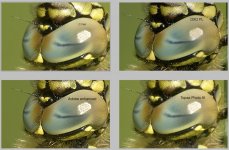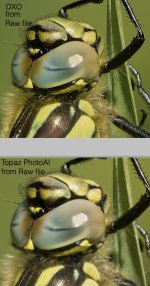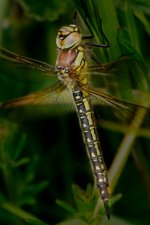- Messages
- 3,270
- Name
- Graham
- Edit My Images
- No
I've noticed AI denoise programs do odd things to textures in bird feathers, but this is a striking example of how AI denoising has affected the pattern of the
ommatidia (the small eyes that make up the big eyes) on this Hairy Dragonfly's compound eye.
The straight demosiaced raw file (NEF) looks very similar from either C1 and Lightroom (Lightroom not illustrated).
The Denoise AI file (Adobe Enhanced) generated in Lightroom, and the NEF file round tripped to Topaz PhotoAI from C1 both look similar to the straight demosaiced files from LR and C1.
BUT the DXO AI denoised files have a substantial change in the pattern of the ommatidia, making them appear to run in distinct lines. I tried both prime and prime XD, as well as altering the sharpening and other settings, but I couldn't get rid of the distinct line patterns. Which, misrepresent the actual patterns.
If you look at the other images, you can see a hint of of the ommatidia forming lines, but these aren't at the same angle as the lines created by DXO.
I'm not exactly sure what conclusions I draw from this. AI denoising gives some wonderful looking results with high ISOs, but equally, even though this is at 200%, for shots like this that might be used for some sort of scientific application, where the patterns shown might be important, it seems worth being aware of.
Superficially, I still feel DXO gives the best looking results, but I am beginning to think that Adobe Denoise AI might give more reliably "realistic" results when looking at things like the eye shown here and the details in feathers. C1 plus Topaz PhotoAI is also a possibility as Topaz seems to be much better than the last time I tried it at avoiding creating weird artifacts.
Note I have used the latest versions of C1, Adobe Denoise and Topaz Photo AI, but it was DXO PL 6 and not the latest version of DXOs denoising tools. This is the same version of denoising as is current in the latest version of DXO (version 7). DXO Pure Raw 4 has jumped a version ahead in terms of denoising, but won't be available in DXO PL until release 8 in the Autumn.
The problem with any of these AI denoising programs is that they aren't consistent, with the "best" choice of software varying between the different files tested. But this was an "impossible not to notice" difference, in results even at low magnification.

Edit: 26th April 2024
To add this, as explained, the Topaz example above was from the processed C1 Nef (ie on a TIFF). This was to see if a Topaz plus C1/LR approach could avoid the artefacting produces by DXO. DXO only works on Raw files.
So using Adobe deNoiseAI, or non AI denoising with LR or C1 with the AI denoising being passed to Topaz PhotoAI, both avoided the artefacting produced by DXP PL6.
However, I've now tried processing the Raw file in Topaz, and it gives results very similar to DXP Pl. Both show the same line artefacts on the eye.

ommatidia (the small eyes that make up the big eyes) on this Hairy Dragonfly's compound eye.
The straight demosiaced raw file (NEF) looks very similar from either C1 and Lightroom (Lightroom not illustrated).
The Denoise AI file (Adobe Enhanced) generated in Lightroom, and the NEF file round tripped to Topaz PhotoAI from C1 both look similar to the straight demosaiced files from LR and C1.
BUT the DXO AI denoised files have a substantial change in the pattern of the ommatidia, making them appear to run in distinct lines. I tried both prime and prime XD, as well as altering the sharpening and other settings, but I couldn't get rid of the distinct line patterns. Which, misrepresent the actual patterns.
If you look at the other images, you can see a hint of of the ommatidia forming lines, but these aren't at the same angle as the lines created by DXO.
I'm not exactly sure what conclusions I draw from this. AI denoising gives some wonderful looking results with high ISOs, but equally, even though this is at 200%, for shots like this that might be used for some sort of scientific application, where the patterns shown might be important, it seems worth being aware of.
Superficially, I still feel DXO gives the best looking results, but I am beginning to think that Adobe Denoise AI might give more reliably "realistic" results when looking at things like the eye shown here and the details in feathers. C1 plus Topaz PhotoAI is also a possibility as Topaz seems to be much better than the last time I tried it at avoiding creating weird artifacts.
Note I have used the latest versions of C1, Adobe Denoise and Topaz Photo AI, but it was DXO PL 6 and not the latest version of DXOs denoising tools. This is the same version of denoising as is current in the latest version of DXO (version 7). DXO Pure Raw 4 has jumped a version ahead in terms of denoising, but won't be available in DXO PL until release 8 in the Autumn.
The problem with any of these AI denoising programs is that they aren't consistent, with the "best" choice of software varying between the different files tested. But this was an "impossible not to notice" difference, in results even at low magnification.

Edit: 26th April 2024
To add this, as explained, the Topaz example above was from the processed C1 Nef (ie on a TIFF). This was to see if a Topaz plus C1/LR approach could avoid the artefacting produces by DXO. DXO only works on Raw files.
So using Adobe deNoiseAI, or non AI denoising with LR or C1 with the AI denoising being passed to Topaz PhotoAI, both avoided the artefacting produced by DXP PL6.
However, I've now tried processing the Raw file in Topaz, and it gives results very similar to DXP Pl. Both show the same line artefacts on the eye.

Last edited:


